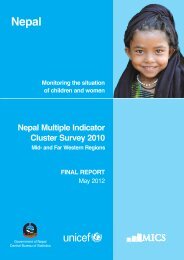Chapter 15 Internal Migration in Nepal - Central Bureau of Statistics
Chapter 15 Internal Migration in Nepal - Central Bureau of Statistics
Chapter 15 Internal Migration in Nepal - Central Bureau of Statistics
You also want an ePaper? Increase the reach of your titles
YUMPU automatically turns print PDFs into web optimized ePapers that Google loves.
The magnitude <strong>of</strong> these streams can not be compared with data provided <strong>in</strong> the previous censuses<br />
as the number <strong>of</strong> urban centres have drastically <strong>in</strong>creased with many <strong>of</strong> the newly designated<br />
urban centres be<strong>in</strong>g rural <strong>in</strong> character. Therefore, <strong>Nepal</strong> still has an overwhelm<strong>in</strong>g rural-to-rural<br />
migration. Rural-to-urban migration is ga<strong>in</strong><strong>in</strong>g more visibility <strong>in</strong> districts with large urban areas<br />
such as Kathmandu (71.8%), Kaski (82.7%), Lalitpur (56.6%), and Bhaktapur (44.6%). <strong>Internal</strong><br />
migrants to urban areas has <strong>in</strong>creased over time from 13.4 per cent <strong>in</strong> 1971, 16.3 per cent <strong>in</strong> 1981,<br />
17.2 per cent <strong>in</strong> 1991 (KC, 1998:20) and 26.8 per cent (746,285 VDC+81,425 municipality) <strong>in</strong><br />
2001 (CBS, 2002: Table 21).<br />
<strong>15</strong>.3.6 <strong>Migration</strong> to Urban Areas<br />
<strong>Nepal</strong> has at present 58 designated urban centres with a total population <strong>of</strong> 3,227,879. Out <strong>of</strong> this<br />
total, 95.6 per cent are native born and 4.4 per cent are foreign born (Table <strong>15</strong>.14). Out <strong>of</strong> the total<br />
native born (3,085,104), 73.2 per cent (2,257,392) were <strong>in</strong>ternal migrants from other districts <strong>in</strong><br />
rural areas, whereas 24.2 per cent migrated from other municipalities. These numbers and<br />
associated proportions are strictly based on the def<strong>in</strong>ition <strong>of</strong> <strong>in</strong>ternal migrants migrat<strong>in</strong>g or<br />
cross<strong>in</strong>g the boundary <strong>of</strong> one district <strong>of</strong> birth place to another district <strong>of</strong> enumeration at the time<br />
<strong>of</strong> the census <strong>in</strong> 2001.<br />
143
















